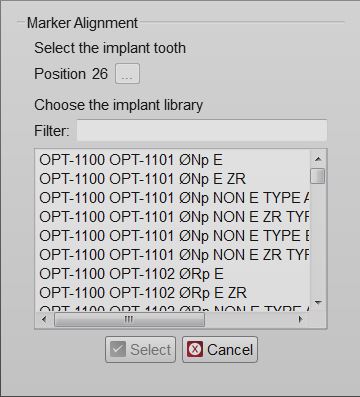Difference between revisions of "Man ImplantAlign"
(Created page with "<languages/> <translate> {{DISPLAYTITLE:Implant Alignment}} = Implant Acquisition = When you acquire the data for a project above implants, acquiring the implant itself is rea...") |
(No difference)
|
Revision as of 07:16, 24 July 2015
Implant Acquisition
When you acquire the data for a project above implants, acquiring the implant itself is really difficult. It's not like a stump or a piece o stone model. The implant connection/interfaces normally are small and metallic.
More than this the fitting need to be mechanically perfect, there is close to no margin of error.
To solve this problem you're not going to scan directly the implant connection but an Implant Marker, a specific object designed to be scanned that fit exactly over the implant you need.
The scan of the implant marker is not enough to work. You need to use this data to compute the exact position of the implant interface. For this you need an Implant Library.
This can be done directly in the CAD software, but if you're using an implant library for the Exocad Platform OpticalRevEng Dental can let you do this alignment directly in the scan software to get better results.
Implant Selection
After the mesh generation, if you select the mesh of an implant marker from the project tree, the Implant Alignment button will appear in the Main Toolbar. You can then click on this button to open the Implant Selection dialog.
This dialog is made by:
- A tooth position selection (the button with three dots ...) that can be used, only in Free Mode to select the tooth position of one implant
- An implant list with all the implants availables in the current implant library
- A Filter box where you can put part of the name of the implant you need and all the implants that match the name will be showed in the implant list
You just need to select the implant you want to use and click the Select Button.
Choosing the right implant from the library need care. Many implant libraries have different versions of every implant connection. For example you can find:
- Engaging Connections : The connection used can not rotate over the implant, for abutments or single restorations
- Not-Engaging Connections : The connection used can rotate over the implant, for bars and bridges
- For Zirconia : Connections with particular shapes, suited for zirconia restorations
If you select the wrong implant you can do again all the procedure to replace the old connection aligned with a new one.
If you start the CAD design with a wrong connection you'll need to redo all the design from the start
Implant Alignment
When you select the implant connection you want to use the software will enter in the Manual Alignment mode.
You'll have to align the marker acquried mesh with the library marker shape. From this data the connection position will be computed
This procedure needs to be done for every implant in the project. The CAD Export will issue a warning if miss one or more implant alignments.
Now that you know how to align an implant acquisition to the implant library you can return to the Main Page or read about Export functions.
